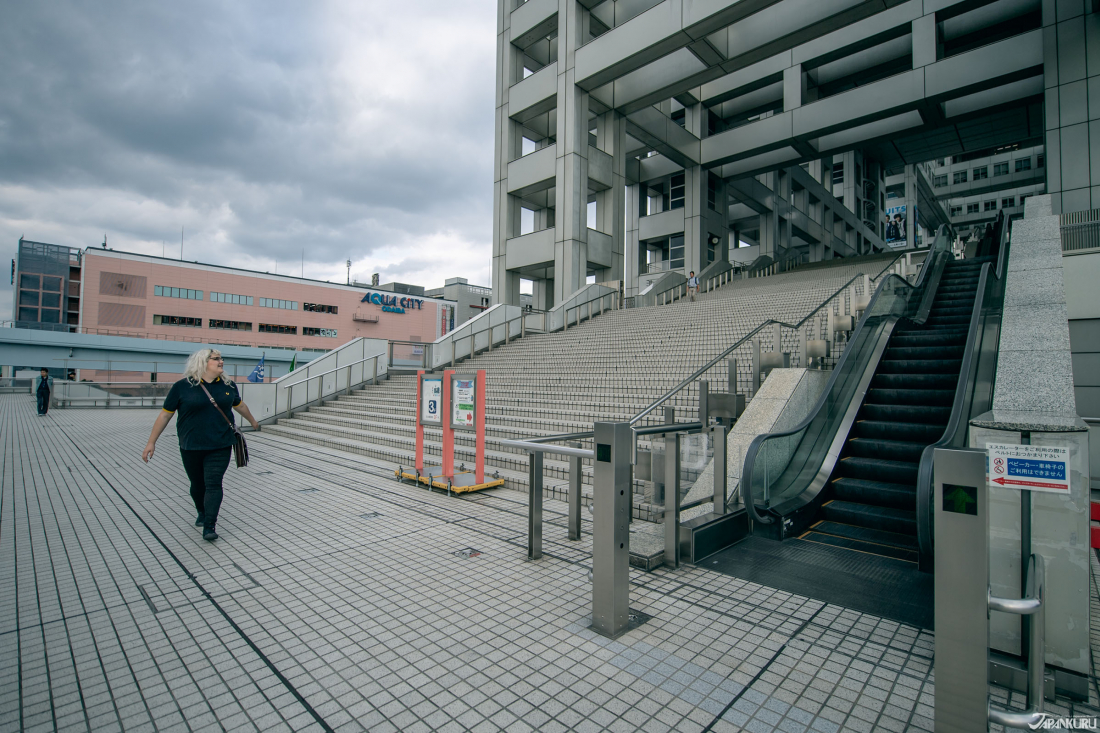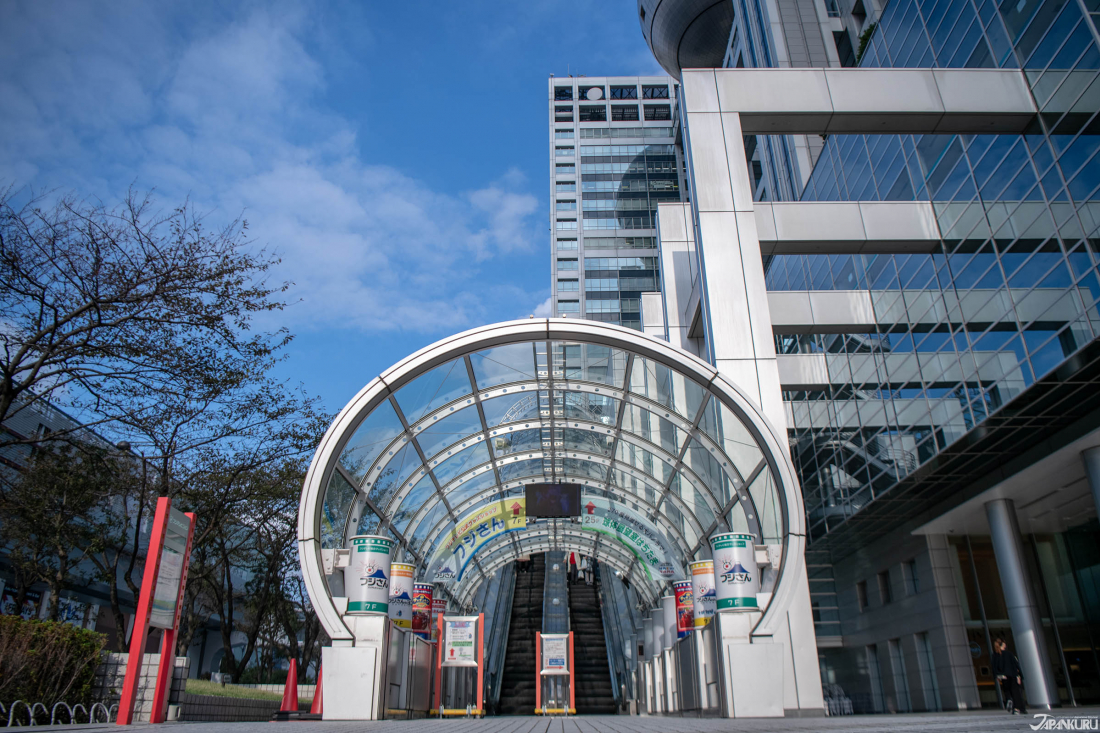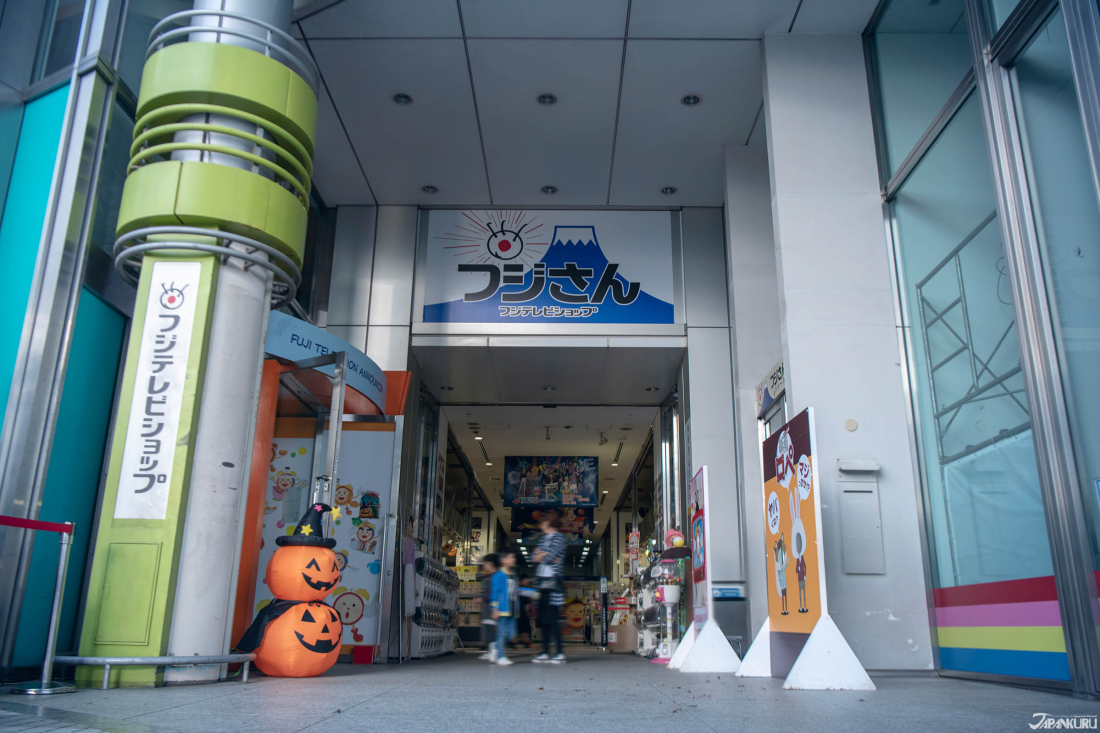
Did you know you can go inside?
Odaiba (お台場) is a popular area in Tokyo that is primarily known for sightseeing spots such as the Odaiba Oedo Onsen Monogatari, AQUA CiTY ODAIBA, Gundam statue (which recently changed to the Unicorn Gundam in 2017), and The National Museum of Emerging Science and Innovation (Miraikan). Aside from the Statue of Liberty, that many people intimidate, and Gundam statue, that goes into destroy mode many times a day, there is another famous symbol of Odaiba, and that is the big ball of the Fuji TV Building. Not many people know this…but you can actually go inside this giant ball! So this time JAPANKURU went to Fuji TV for the first time to see what we could learn about one of Japan's major TV stations.
●FUJI TV (フジテレビ)
Google Maps
◉Fuji TV Observation Deck
⏰10am〜6pm
12/12/2018〜1/6/2019: 10am〜8pm (last entry until 7:30)
💰Adults (high school+) 550yen, Children 300yen
◉Fuji TV Shop "Mt. Fuji (Fuji-san)"
⏰10am~6pm
Official website (ENG)
Observation Deck info page (JPN)
The closest station from the Fuji TV Building is Daiba Station on the Yurikamome Line, but you can also get there from the Rinkai Line's Tokyo Teleport Station. Once you get to the building, there are 2 different entrances in. If you are already on the overhead passenger walk, then you can take the escalator that goes in between the building. Or if you are coming from down below on the ground, there is an entrance there to the far left of the building as well.
◉Fuji TV Shop "Mt. Fuji (Fuji-san)"
⏰10am~6pm
Here at the Fuji TV Mall you can see a lot of props and scripts here. Along with there is a Chuggington and Sazae-san shop that is filled with goods from these two popular shows primarily with children on Fuji TV. And a convenient store Lawson inside which is a life saver. More than anything the mall is a great place to relax a bit. It is hard finding a place to just chill for a while without being forced to buy something in Odaiba. That's what makes this spot a great place.
◉Fuji TV Observation Deck
⏰10am〜6pm
12/22/2018〜1/6/2019: 10am〜8pm (last entry until 7:30)
💴Adults (high school+) 550yen, Children 300yen
On the main floor is the main observatory, that has huge windows offering great, scenic views in all directions. The view of Odaiba is easily the main attraction, but there are also things to do while on the main floor. They have special events often so it is not always the same, but currently, with the theme of a "sports park" there are a lot of interactive activities like VR, bouldering, ping pong, and basketball. We were told the next special event to be held will involve Dragon Ball Z!
Like we said, visiting the Fuji TV Observation Deck gives you a prime view of the prettiest part of the city, with Rainbow Bridge, yakatabune (a unique Japanese-style wooden tour boat that shines at night), and other things in the background. The real transformation of the city changes once it gets dark. Once it gradually got darker more and more people came and began setting up their camera stands. We did not know until recently that you could even have access to Fuji TV, but apparently many people come every day just to take cityscape pictures/videos/time-lapse photos of Tokyo Bay and stay until close time. Which is why we are so thankful the Fuji TV Observation Deck extended their business hours until 8pm. It really opened our eyes, giving us a whole new angle and view of Odaiba and Tokyo. So if you are a photography fan or just like visiting observation decks, this can be your little secret spot.
Photo credit: 花火写真家 金武武
In perfect timing, Odaiba will be having one their most famous firework displays, the "Odaiba Rainbow Hanabi (fireworks)". The "Odaiba Rainbow Fireworks" is held every winter when the skies are clear so that you can see the fireworks at their best. Not only will there be fireworks, but the Odaiba area will also be lit up with colorful lights so you can really enjoy the bay area. On Saturday, 22nd, there will also be music accompanying the fireworks🎆♪♬ You can enjoy the fireworks from many spots in Odaiba, but for the perfect view and photo spot, viewing it from Fuji TV would be your best bet.
🎆Odaiba Rainbow Fireworks 2018
📅 December 1, 8, 15, 22, 29 (every Saturday)
⏰Starts at 7pm
Inside the ball there are several floors that you can check out. Aside from just seeing the beautiful view from inside the observation deck, you can explore the actual set used for the network's most popular TV show Mezamashi TV (めざましテレビ), which is a morning news and talk show. The brightly-colored set give you a glimpse of Japan's TV culture. We for one LOVE how bright and almost chaotic the sets are for most talk shows in here in Tokyo. Everything on the set from the tables to the light fixtures are original. There is also an autograph wall across from the set showing Japanese and international celebrities who have visited the set.
Part of the fun of visiting Fuji TV's observation deck is the chance to check out the building itself. Normally you would think a TV station would not be open to the public, which is what makes the Fuji TV Building so great. The building itself is probably the most distinctive-looking building in Odaiba, so being granted access is like a dream come true.
●FUJI TV (フジテレビ)
Google Maps
⏰10am〜6pm
12/12/2018〜1/6/2019: 10am〜8pm (last entry until 7:30)
💰Adults (high school+) 550yen, Children 300yen
Official website (ENG)
Observation Deck info page (JPN)
Be sure to look at JAPANKURU🐶 for more exciting articles every day!!
Or add us on Instagram and Facebook to share your Japanese pictures💖🗾
Details
NAME:FUJI TV (フジテレビ)
MAP
2-4-8 Daiba, Minato-ku, Tokyo
東京都港区台場2丁目4−8
COMMENT
FEATURED MEDIA
VIEW MORE 
A New Tokyo Animal Destination: Relax & Learn About the World’s Animals in Japan
#pr #japankuru #anitouch #anitouchtokyodome #capybara #capybaracafe #animalcafe #tokyotrip #japantrip #카피바라 #애니터치 #아이와가볼만한곳 #도쿄여행 #가족여행 #東京旅遊 #東京親子景點 #日本動物互動體驗 #水豚泡澡 #東京巨蛋城 #เที่ยวญี่ปุ่น2025 #ที่เที่ยวครอบครัว #สวนสัตว์ในร่ม #TokyoDomeCity #anitouchtokyodome

Shohei Ohtani Collab Developed Products & Other Japanese Drugstore Recommendations From Kowa
#pr #japankuru
#kowa #syncronkowa #japanshopping #preworkout #postworkout #tokyoshopping #japantrip #일본쇼핑 #일본이온음료 #오타니 #오타니쇼헤이 #코와 #興和 #日本必買 #日本旅遊 #運動補充能量 #運動飲品 #ช้อปปิ้งญี่ปุ่น #เครื่องดื่มออกกำลังกาย #นักกีฬา #ผลิตภัณฑ์ญี่ปุ่น #อาหารเสริมญี่ปุ่น

도쿄 근교 당일치기 여행 추천! 작은 에도라 불리는 ‘가와고에’
세이부 ‘가와고에 패스(디지털)’ 하나면 편리하게 이동 + 가성비까지 완벽하게! 필름카메라 감성 가득한 레트로 거리 길거리 먹방부터 귀여움 끝판왕 핫플&포토 스폿까지 총집합!
Looking for day trips from Tokyo? Try Kawagoe, AKA Little Edo!
Use the SEIBU KAWAGOE PASS (Digital) for easy, affordable transportation!
Check out the historic streets of Kawagoe for some great street food and plenty of picturesque retro photo ops.
#pr #japankuru #도쿄근교여행 #가와고에 #가와고에패스 #세이부패스 #기모노체험 #가와고에여행 #도쿄여행코스 #도쿄근교당일치기 #세이부가와고에패스
#tokyotrip #kawagoe #tokyodaytrip #seibukawagoepass #kimono #japantrip

Hirakata Park, Osaka: Enjoy the Classic Japanese Theme Park Experience!
#pr #japankuru #hirakatapark #amusementpark #japantrip #osakatrip #familytrip #rollercoaster #retrôvibes #枚方公園 #大阪旅遊 #關西私房景點 #日本親子旅行 #日本遊樂園 #木造雲霄飛車 #히라카타파크 #สวนสนุกฮิราคาตะพาร์ค

🍵Love Matcha? Upgrade Your Matcha Experience With Tsujiri!
・160년 전통 일본 말차 브랜드 츠지리에서 말차 덕후들이 픽한 인기템만 골라봤어요
・抹茶控的天堂!甜點、餅乾、飲品一次滿足,連伴手禮都幫你列好清單了
・ส่องมัทฉะสุดฮิต พร้อมพาเที่ยวร้านดังในอุจิ เกียวโต
#pr #japankuru #matcha #matchalover #uji #kyoto #japantrip #ujimatcha #matchalatte #matchasweets #tsujiri #말차 #말차덕후 #츠지리 #교토여행 #말차라떼 #辻利抹茶 #抹茶控 #日本抹茶 #宇治 #宇治抹茶 #日本伴手禮 #抹茶拿鐵 #抹茶甜點 #มัทฉะ #ของฝากญี่ปุ่น #ชาเขียวญี่ปุ่น #ซึจิริ #เกียวโต

・What Is Nenaito? And How Does This Sleep Care Supplement Work?
・你的睡眠保健品——認識「睡眠茶氨酸錠」
・수면 케어 서플리먼트 ‘네나이토’란?
・ผลิตภัณฑ์เสริมอาหารดูแลการนอน “Nenaito(ネナイト)” คืออะไร?
#pr #japankuru #sleepcare #japanshopping #nenaito #sleepsupplement #asahi #睡眠茶氨酸錠 #睡眠保健 #朝日 #l茶胺酸 #日本藥妝 #日本必買 #일본쇼핑 #수면 #건강하자 #네나이토 #일본영양제 #อาหารเสริมญี่ปุ่น #ช้อปปิ้งญี่ปุ่น #ร้านขายยาญี่ปุ่น #ดูแลตัวเองก่อนนอน #อาซาฮิ

Japanese Drugstore Must-Buys! Essential Items from Hisamitsu® Pharmaceutical
#PR #japankuru #hisamitsu #salonpas #feitas #hisamitsupharmaceutical #japanshopping #tokyoshopping #traveltips #japanhaul #japantrip #japantravel

Whether you grew up with Dragon Ball or you just fell in love with Dragon Ball DAIMA, you'll like the newest JINS collab. Shop this limited-edition Dragon Ball accessory collection to find some of the best Dragon Ball merchandise in Japan!
>> Find out more at Japankuru.com! (link in bio)
#japankuru #dragonball #dragonballdaima #animecollab #japanshopping #jins #japaneseglasses #japantravel #animemerch #pr

This month, Japankuru teamed up with @official_korekoko to invite three influencers (originally from Thailand, China, and Taiwan) on a trip to Yokohama. Check out the article (in Chinese) on Japankuru.com for all of their travel tips and photography hints - and look forward to more cool collaborations coming soon!
【橫濱夜散策 x 教你怎麼拍出網美照 📸✨】
每次來日本玩,是不是都會先找旅日網紅的推薦清單?
這次,我們邀請擁有日本豐富旅遊經驗的🇹🇭泰國、🇨🇳中國、🇹🇼台灣網紅,帶你走進夜晚的橫濱!從玩樂路線到拍照技巧,教你怎麼拍出最美的夜景照。那些熟悉的景點,換個視角說不定會有新發現~快跟他們一起出發吧!
#japankuru #橫濱紅磚倉庫 #汽車道 #中華街 #yokohama #japankuru #橫濱紅磚倉庫 #汽車道 #中華街 #yokohama #yokohamaredbrickwarehouse #yokohamachinatown

If you’re a fan of Vivienne Westwood's Japanese designs, and you’re looking forward to shopping in Harajuku this summer, we’ve got important news for you. Vivienne Westwood RED LABEL Laforet Harajuku is now closed for renovations - but the grand reopening is scheduled for July!
>> Find out more at Japankuru.com! (link in bio)
#japankuru #viviennewestwood #harajuku #omotesando #viviennewestwoodredlabel #viviennewestwoodjapan #비비안웨스트우드 #오모테산도 #하라주쿠 #日本購物 #薇薇安魏斯伍德 #日本時尚 #原宿 #表參道 #japantrip #japanshopping #pr

Ready to see TeamLab in Kyoto!? At TeamLab Biovortex Kyoto, the collective is taking their acclaimed immersive art and bringing it to Japan's ancient capital. We can't wait to see it for ourselves this autumn!
>> Find out more at Japankuru.com! (link in bio)
#japankuru #teamlab #teamlabbiovortex #kyoto #kyototrip #japantravel #artnews
Photos courtesy of teamLab, Exhibition view of teamLab Biovortex Kyoto, 2025, Kyoto ® teamLab, courtesy Pace Gallery

Japanese Makeup Shopping • A Trip to Kamakura & Enoshima With Canmake’s Cool-Toned Summer Makeup
#pr #canmake #enoshima #enoden #에노시마 #캔메이크 #japanesemakeup #japanesecosmetics

⚔️The Robot Restaurant is gone, but the Samurai Restaurant is here to take its place. Check it out, and don't forget your coupon!
🍣신주쿠의 명소 로봇 레스토랑이 사무라이 레스토랑으로 부활! 절찬 쿠폰 발급중
💃18歲以上才能入場的歌舞秀,和你想的不一樣!拿好優惠券去看看~
#tokyo #shinjuku #samurairestaurant #robotrestaurant #tokyotrip #도쿄여행 #신주쿠 #사무라이레스토랑 #이색체험 #할인이벤트 #歌舞伎町 #東京景點 #武士餐廳 #日本表演 #日本文化體驗 #japankuru #japantrip #japantravel #japanlovers #japan_of_insta

Japanese appliance & electronics shopping with our KOJIMA x BicCamera coupon!
用JAPANKURU的KOJIMA x BicCamera優惠券買這些正好❤️
코지마 x 빅 카메라 쿠폰으로 일본 가전 제품 쇼핑하기
#pr #japankuru #japanshopping #kojima #biccamera #japaneseskincare #yaman #dji #osmopocket3 #skincaredevice #日本購物 #美容儀 #相機 #雅萌 #日本家電 #일본여행 #면세 #여행꿀팁 #일본쇼핑리스트 #쿠폰 #일본쇼핑 #일본브랜드 #할인 #코지마 #빅카메라 #japankurucoupon






































































